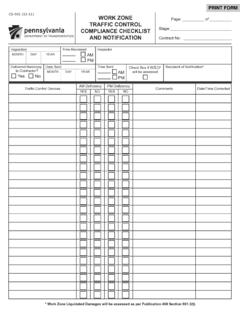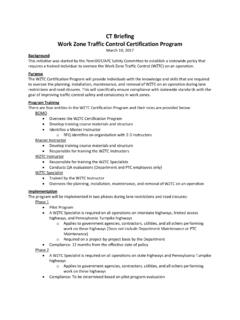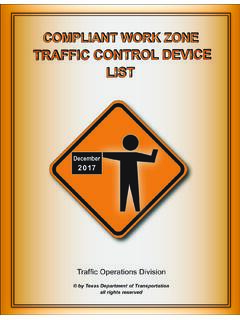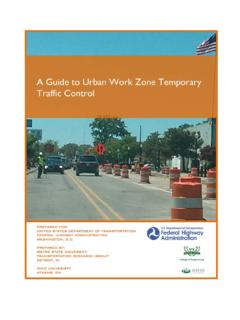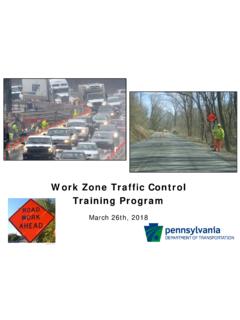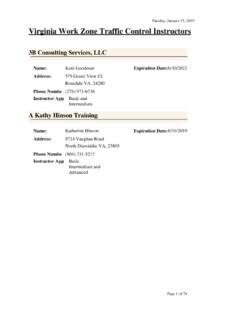Transcription of Control Plans and Intrusion Prevention - mapyourshow.com
1 WorkZone Safety: traffic Control Plans and Intrusion Prevention Basic work Zone traffic Control Principles External traffic Control Intrusion of the Traveling Population Employees exposed to traffic Internal traffic Control Roadway types Elements needing consideration Resources Program References Bruce W Drewes- 3T Group 33 Years in Transportation and Construction National work Zone Safety Clearinghouse Road Safety Plus In construction, workers are injured or killed most often by Workers Struck By Motorists Workers Struck By Equipment Source: Bureau of Labor Statistics 0501001502002503002005200620072008200920 10 Other FatalitiesWorkers Struck by Vehicle/EquipmentJob-Related Fatalities in Road Construction Runovers and backovers are number one cause of death All traffic Control NEEDS TO BE PLANNED , consider: Roadway Dynamics Roadway geometrics, number of lanes, features Volumes (Peak and Off Peak), and types of vehicles (Cars, Trucks, Buses, Oversized) Pedestrians and Bicyclist Construction Dynamics Duration and Type of Project (Paving, Seal Coating, Reconstruction) Type, Size and Volume of Construction Equipment Access and Egress of Construction Equipment Time of Day Interaction of Construction Equipment and the Worker on Foot Keeping the Worker on Foot in the work Zone Basic work Zone traffic Control Principles Special Considerations Develop both an External and Internal traffic Control Plan Type of devices used to separate the External traffic from the Internal traffic (MUTCD Subpart J and Subpart K) Installation, Maintenance and Removal of traffic Control Arrow and Variable Message Boards Use of Law Enforcement (Passive and Non Passive Enforcement)
2 Use of Nonvariable or Variable Speed Reductions Development of Performance Standards for traffic Control Photo Enforcement Standards Federal Standards: Manual of Uniform traffic Control Devices (Minimums) Subpart J, work Zone Safety and Mobility, Compliance date Oct. 12, 2007 Subpart K, Temporary traffic Control Devices Rule, Compliance date Dec. 4, 2008 State and Local Standards Each State DOT has developed additional requirement in Compliance with Subpart J and K. Resources: External traffic Control Key Elements To Remember Your employees and company s welfare is based in how well you deal with traffic Control . The traffic Control is how you communicate with the traveling public, insure a clear message. Use advanced items to improve that communication (Flags, flashing warning lights, Rumble strips, Message or Arrow Boards). Remove the traffic Control signs and devices when they are not needed Track the performance of your traffic Control Sub Contractor.
3 Insure that everyone is trained. Negotiation of Responsibilities Contractor Planning Phase Meeting participation Use of law enforcement Location of access/egress points Lane encroachments Assignment of Duties Additional Elements Use of Law Enforcement Passive Enforcement Aggressive Enforcement Location for officer Location to stop Speeders Variable Speed Limits Has to be approved by Highway Agency Static Posting Post mounted signs Electronic Signs In long term operations Currently used with permanent applications Resources MUTCD, Section Page 621 and 622 Employee moving outside of the traffic Control ITC coordinates construction traffic inside ACTIVITY AREA of a temporary traffic Control zone (TTCP) What Is Internal traffic Control ? Goal is a plan to separate construction vehicles/equipment from workers on foot TTCP Temporary traffic Control Plan for facilitating road users through a work zone ITC plan fills in details on how construction traffic should flow inside area marked by hatched box on TTCP * * Effective ITC protocol informs all parties operating within the work space of the locations of others Overview of Internal traffic Control ITC creates zones to minimize interaction between workers on foot and construction vehicles ITC plan designates routes and operating procedures for large trucks delivering materials ITC plan creates a traffic pattern to minimize backing by construction vehicles/equipment ITC facilitates communication among key work zone parties in advance of arrival to the site Construction vehicles are the greatest hazard Issues?
4 Concrete Barricade 305 177 73 32 23 70 15 9 8 5 050100150200250300350 All CasesAll TrucksDump TruckPickup TruckSemiCarRoller, PaverGrader, Scraper, Injuries at Road Construction Sites: Recent 10-Year Period Source: Bureau of Labor Statistics / Stephen Pegula More workers are killed by construction vehicles than by motorists Blind Spots What Are Blind Spots? Locations around equipment and vehicles where workers on foot are invisible to the operator through the windows/mirrors Behind Vehicle Outside Mirror Range Workers on foot are vulnerable in blind spots Be familiar with unique blind spots of each vehicle EXAMPLES: Blind Spots Gray areas = blind spots Yellow hatch lines = visible in mirrors Workers are also struck and killed by motorists Workers may stray into traffic when Preoccupied by work Become comfortable in dangerous environment No convenient access to and from work space - Rest rooms - Food and water - Shade breaks - Other local work areas - Staging of company and personal vehicles Workers cross traffic lanes (especially in high-speed locations)
5 Workers must be visible against surroundings Workers must be visible with high visibility garments Worker Visibility Safe Practices for Workers on Foot Workers must be visible in a variety of conditions especially at night, in other low-light conditions, and in inclement weather Spotters should be used when backing is required near workers on foot Recommended by ANSI and other agencies Required by some states when camera/radar systems not used Designate a Spotter Safe Practices for Drivers and Operators Can also be in danger from vehicles who is spotting the spotter? Can help when you must work with your back to equipment or traffic If visual contact is lost, stop immediately until the spotter is located Brad if you tell us which states, we can color them for identification! Worker-Free and Equipment-Free zones = Worker-Free Zone Paver Lane 1 Lane 2 Breakdown Lane Worker Area Exit Enter Staging Area Which Areas Should Be Worker-Free zones ?
6 Integrated Process Temporary traffic Control Plan Project Management and Scheduling Subcontractor Communications Occupational Safety and Health Quality Control Worker Safety Management Elements Addressed Communications ITCP operations communication plan should include - Communications regarding changes to the ITCP - Means for workers on foot to talk with operators, truck drivers, others coordinating access and egress of vehicles, and the movement of heavy equipment within the work space - Means for equipment operators to communicate with each other and with key site personnel - Plan for orienting independent truck drivers and subcontractors to the work space and the ITCP Resources MUTCD National work Zone Safety Clearinghouse Road Safety Plus




